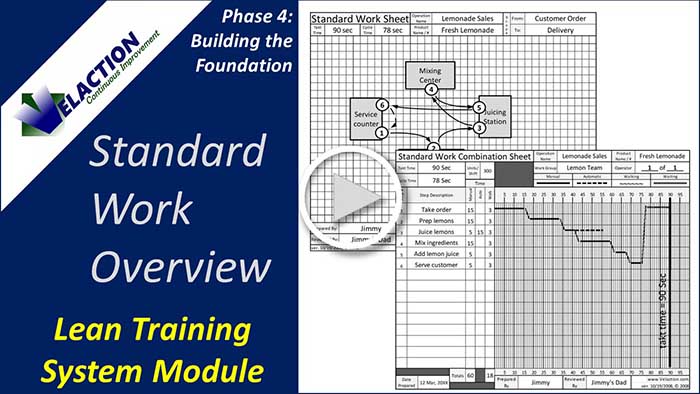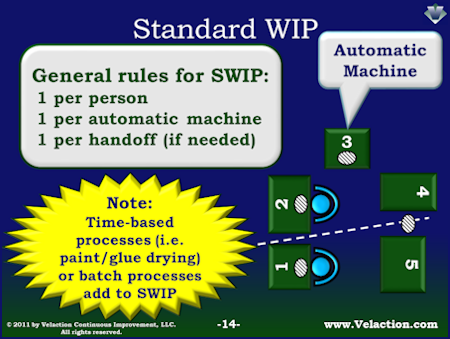Standard Work-in-Process
Standard work-in-process (or Standard WIP, or SWIP) is the designated minimum amount of material needed to keep your Standard Work flowing.
It is one of the three main components of Standard Work. The other components include balancing the work to the takt time, and assigning it to a single operator.
The consistent quantities designated by standard work-in-process help reduce variation and eliminate the accordion like effect that fluctuating work-in-process has on lead time.

The purpose of standard WIP is to enable consistency in a process. The logic behind its use is sound. If an operator works on five units in a batch, then three, and then seven, the interval between passing that work on to the next process obviously fluctuates.
As an organization becomes more and more Lean, each person within that team has less buffer in his or her process. They need their materials delivered to them on time, each and every time. So if an upstream process is not disciplined on how much they’re working on, they will never be able to meet the precise delivery times that are expected of them.
Calculating Standard Work-in-Process
Determining how much standard work-in-process you need is a fairly straightforward process.
This image comes from our Standard Work Overview class.
- Each operator needs something to work on. Common sense applies here. If you have a U-shaped cell, with three operators in it, there must be three pieces of work for that team.
- Each automatic machine needs something to work on. If a machine is not manned by an operator the entire time, it must have a piece of standard work-in-process to keep it flowing.
- One piece of SWIP per handoff. If handoffs are precisely coordinated, as in a moving assembly line, there is no need for this transitional WIP. But if there is not a close linkage, you may need to add one unit to the standard work-in-process between operators. In effect, it is a kanban square between an upstream supplier and downstream customer. Note that in some circumstances you may need multiple handoffs between operators, as in when two or three operators are working the same U-shaped cell. In these cases, you may have to experiment to find the proper locations to place these kanbans. Also keep in mind that your ultimate goal is to link the processes and eliminate this transitional WIP.
- Curtain processes. A curtain process occurs when a batch production step is contained within a series of processes operating with single piece flow. Most commonly, this involves a large machine, often called a monument. Generally, you’ll add twice the batch quantity to your standard WIP. Obviously, the machine is working on one batch. The other batch quantity will be split between two locations. The upstream process will add one item to the upstream location, providing work for the next machine batch. The downstream process will draw from the downstream location, which will contain the work from the previous batch cycle. That is where the term curtain process comes from. If you imagined all that taking place behind the curtain, it would look like flow. One piece goes in and one-piece comes out.
Even with a batch process, though, you still want to minimize the amount of work in process. Your batch size should be set to no larger than the machine cycle time divided by the takt time.
- Time-based processes. Paint drying and glue or epoxy curing are both time-based processes. It may take longer than a single takt for the step to be completed. The basic rule here is that you need an amount of standard WIP equal to the process time divided by the takt. You will end up with a row of items in various stages of completion while production is going on.

Standard Work-in-Process Words of Warning:
- Don’t forget to designate locations for any standard work-in-process that is not absolutely intuitive.
- Transitional WIP, though standard, is still an indication of lack of flow. Just because the WIP is set at a standard quantity doesn’t mean you should stop working to reduce it.
- When determining SWIP, err on the side of too much rather than too little. You’ll soon realize that you can pull some out, but if you set it too low, you won’t be able to establish flow.

There is a common belief that more is better in the production world, and this is especially prevalent at the frontline. It is understandable, as most non-Lean leaders see a line stop as a bad thing. So they would rather add inventory to hide the problem than commit the resources to resolve the issue permanently.
As a result, many operators like to work ahead to prevent shortages. This, however, creates a substantial amount of waste of overproduction. Of note, Taiichi Ohno, the father of modern Lean, considers this to be the worst form of waste.
The concept of standard WIP can be counterintuitive to some. But as variation is reduced and buffer time is eliminated, there is more of a need for consistency. That means uncovering the problems that are hidden by piles of WIP so they can be addressed, and it means taking out the fluctuations in lead times that comes from working on different amounts of material every time the process is performed.

Getting used to standard WIP can be hard for many employees. You can help by providing resources to work on the problems that team members are trying to protect against when they add piles of materials to the system.
You can also make producing more than SWIP difficult by limiting space in a work area. If there is nowhere to put the product, people can’t build ahead.

Standard WIP Key Points:
- Standard work-in-process is one of the three components of Standard Work.
- SWIP creates the opportunity for consistent delivery times.
![]()
If you are unfamiliar with Standard Work, attempt to put it in place in your most consistent processes. Start out by documenting the issues that occur in the work area and see if there are any that can be reduced prior to trying to standardize the whole process. It is something of a “chicken or the egg” situation, in that putting standardization in place requires some consistency, but getting consistency demands standardization.
Often, when you catalog the problems, you’ll identify several that have fairly straightforward solutions or stopgaps that can add some stability. It will make implementing Standard Work much easier.
When you establish Standard Work, which includes designating SWIP, remove excessive flat surfaces from the work area. This will act as a barrier to overproduction.




0 Comments